【英语】英语倒装句解题技巧及经典题型及练习题(含答案)
(英语)中考必备英语倒装句技巧全解及练习题(含答案)

(英语)中考必备英语倒装句技巧全解及练习题(含答案)一、倒装句1.—Would your younger brother go for a picnic this Sunday?—If I don't go, _______.A. so does heB. so he willC. neither will heD. neither does he【答案】 C【解析】【分析】句意:—你的弟弟这星期天会去野餐吗?—如果我不去,他也不会去。
根据句意“他也不会去”应用固定结构“neither/nor+系动词/助动词/情态动词+主语”,因为是将来不会去,所以用助动词will,故选C。
【点评】考查倒装。
2.— I think the plan is just a waste of time. What do you think?— Well, if you don't support the plan, ________.A. neither do IB. so do IC. neither will ID. so will I【答案】 C【解析】【分析】句意:——我认为这个计划只是在浪费时间。
您是怎么想的?——好,如果你不支持这个计划,我也不支持。
Neither+助动词+主语,表示主语也不是……;这里是if引导的条件状语从句,主句用一般将来时,从句用一般现在时态,这里是主句,故助动词用will。
根据题意,故选C。
【点评】考查倒装句,注意Neither+助动词+主语,表示主语也不是这样;so+助动词+主语,表示主语也是这样。
3.—He's never been late for school.—________________.A. So have IB. So am IC. Neither have ID. Nor am I【答案】 C【解析】【分析】句意:—他从来没有上学迟到过。
英语倒装句常见题型及答题技巧及练习题(含答案)含解析
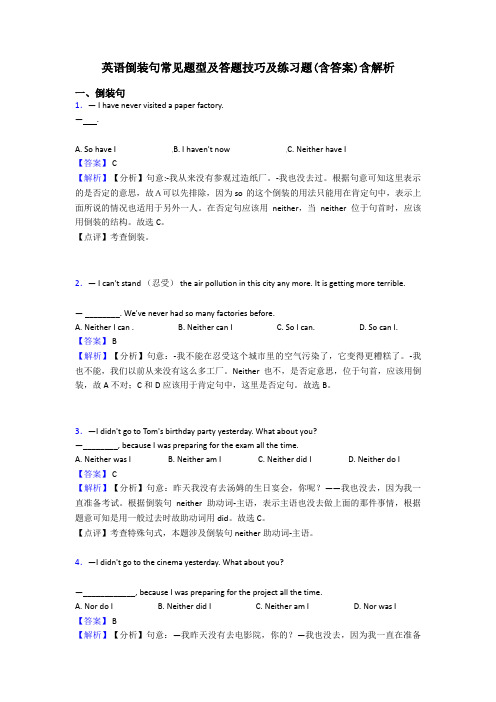
英语倒装句常见题型及答题技巧及练习题(含答案)含解析一、倒装句1.— I have never visited a paper factory.— .A. So have IB. I haven't nowC. Neither have I【答案】 C【解析】【分析】句意:-我从来没有参观过造纸厂。
-我也没去过。
根据句意可知这里表示的是否定的意思,故A可以先排除,因为so 的这个倒装的用法只能用在肯定句中,表示上面所说的情况也适用于另外一人。
在否定句应该用neither,当neither 位于句首时,应该用倒装的结构。
故选C。
【点评】考查倒装。
2.— I can't stand (忍受) the air pollution in this city any more. It is getting more terrible.— ________. We've never had so many factories before.A. Neither I can .B. Neither can IC. So I can.D. So can I.【答案】 B【解析】【分析】句意:-我不能在忍受这个城市里的空气污染了,它变得更糟糕了。
-我也不能,我们以前从来没有这么多工厂。
Neither也不,是否定意思,位于句首,应该用倒装,故A不对;C和D应该用于肯定句中,这里是否定句。
故选B。
3.—I didn't go to Tom's birthday party yesterday. What about you?—________, because I was preparing for the exam all the time.A. Neither was IB. Neither am IC. Neither did ID. Neither do I【答案】 C【解析】【分析】句意:昨天我没有去汤姆的生日宴会,你呢?——我也没去,因为我一直准备考试。
英语倒装句及其解题技巧及练习题(含答案)含解析
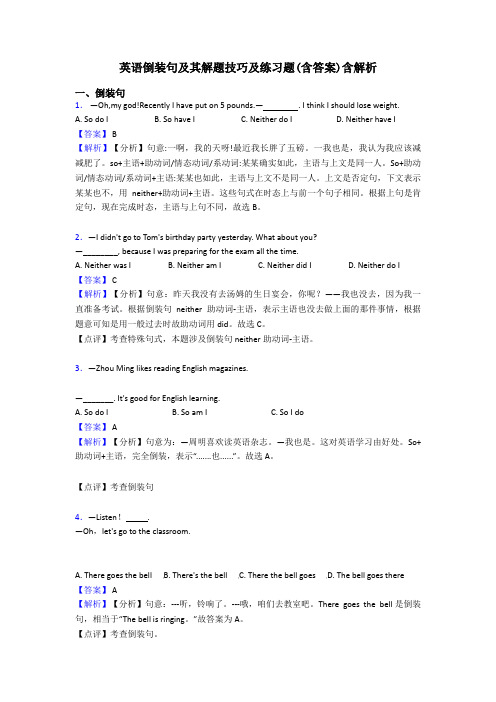
英语倒装句及其解题技巧及练习题(含答案)含解析一、倒装句1.—Oh,my god!Recently I have put on 5 pounds.—. I think I should lose weight.A. So do IB. So have IC. Neither do ID. Neither have I【答案】 B【解析】【分析】句意:一啊,我的天呀!最近我长胖了五磅。
一我也是,我认为我应该减减肥了。
so+主语+助动词/情态动词/系动词:某某确实如此,主语与上文是同一人。
So+助动词/情态动词/系动词+主语:某某也如此,主语与上文不是同一人。
上文是否定句,下文表示某某也不,用neither+助动词+主语。
这些句式在时态上与前一个句子相同。
根据上句是肯定句,现在完成时态,主语与上句不同,故选B。
2.—I didn't go to Tom's birthday party yesterday. What about you?—________, because I was preparing for the exam all the time.A. Neither was IB. Neither am IC. Neither did ID. Neither do I【答案】 C【解析】【分析】句意:昨天我没有去汤姆的生日宴会,你呢?——我也没去,因为我一直准备考试。
根据倒装句neither助动词-主语,表示主语也没去做上面的那件事情,根据题意可知是用一般过去时故助动词用did。
故选C。
【点评】考查特殊句式,本题涉及倒装句neither助动词-主语。
3.—Zhou Ming likes reading English magazines.—_______. It's good for English learning.A. So do IB. So am IC. So I do【答案】 A【解析】【分析】句意为:—周明喜欢读英语杂志。
【英语】英语倒装句(一)解题方法和技巧及练习题含解析
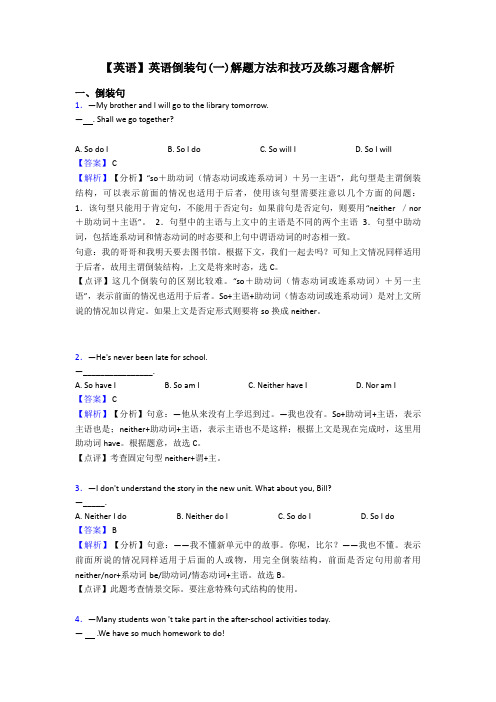
【英语】英语倒装句(一)解题方法和技巧及练习题含解析一、倒装句1.—My brother and I will go to the library tomorrow.— . Shall we go together?A. So do IB. So I doC. So will ID. So I will【答案】 C【解析】【分析】“so+助动词(情态动词或连系动词)+另一主语”,此句型是主谓倒装结构,可以表示前面的情况也适用于后者,使用该句型需要注意以几个方面的问题:1.该句型只能用于肯定句,不能用于否定句:如果前句是否定句,则要用“neither /nor +助动词+主语”。
2.句型中的主语与上文中的主语是不同的两个主语3.句型中助动词,包括连系动词和情态动词的时态要和上句中谓语动词的时态相一致。
句意:我的哥哥和我明天要去图书馆。
根据下文,我们一起去吗?可知上文情况同样适用于后者,故用主谓倒装结构,上文是将来时态,选C。
【点评】这几个倒装句的区别比较难。
“so+助动词(情态动词或连系动词)+另一主语”,表示前面的情况也适用于后者。
So+主语+助动词(情态动词或连系动词)是对上文所说的情况加以肯定。
如果上文是否定形式则要将so换成neither。
2.—He's never been late for school.—________________.A. So have IB. So am IC. Neither have ID. Nor am I【答案】 C【解析】【分析】句意:—他从来没有上学迟到过。
—我也没有。
So+助动词+主语,表示主语也是;neither+助动词+主语,表示主语也不是这样;根据上文是现在完成时,这里用助动词have。
根据题意,故选C。
【点评】考查固定句型neither+谓+主。
3.—I don't understand the story in the new unit. What about you, Bill?—_____.A. Neither I doB. Neither do IC. So do ID. So I do【答案】 B【解析】【分析】句意:——我不懂新单元中的故事。
(英语)初中英语倒装句常见题型及答题技巧及练习题(含答案)

(英语)初中英语倒装句常见题型及答题技巧及练习题(含答案)一、倒装句1.-I don't know about you, but I'm sick and tired of this weather.-_______. I can't stand all this rain.A. I don't careB. It's hard to sayC. So am ID. I hope not【答案】 C【解析】【分析】A. I don't care 我不在乎 B. It's hard to say很难说C. So am I 我也是 D. I hope not我希望不要这样;句意:我不知道你的情况,但是我生病了,讨厌这种天气。
我也是,我忍受不了这雨了。
故选C【点评】“So+谓语+主语”此句型为倒装结构,其主语与上文句子中的主语是不同的。
so代表上句中陈述的肯定内容。
谓语可以是连系动词、情态动词或助动词,且必须与上句中的谓语动词保持时态的一致,意思为“…也是如此”。
“So+ 主 + 谓”表示讨论同一人做某事。
2.—I don't understand the story in the new unit. What about you, Bill?—_____.A. Neither I doB. Neither do IC. So do ID. So I do【答案】 B【解析】【分析】句意:——我不懂新单元中的故事。
你呢,比尔?——我也不懂。
表示前面所说的情况同样适用于后面的人或物,用完全倒装结构,前面是否定句用前者用neither/nor+系动词be/助动词/情态动词+主语。
故选B。
【点评】此题考查情景交际。
要注意特殊句式结构的使用。
3.—Many students won 't take part in the after-school activities today.— .We have so much homework to do!A. So will IB. So do IC. Neither will ID. Neither do I【答案】 C【解析】【分析】句意:—今天许多学生不愿意参见课外活动。
最新初中英语倒装句解题技巧和训练方法及练习题(含答案)
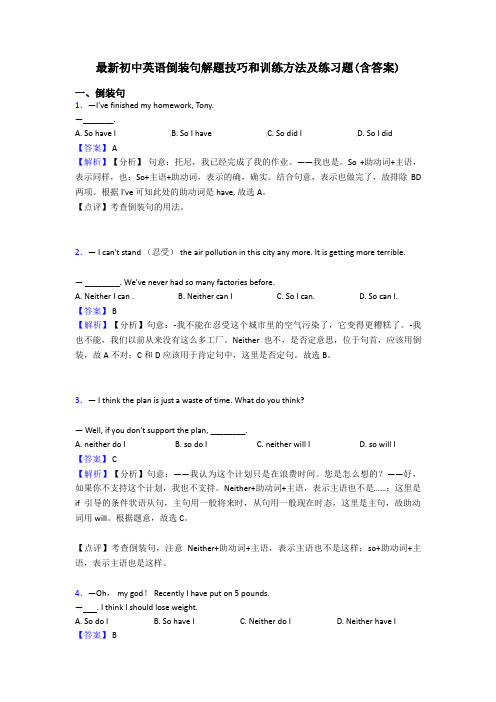
最新初中英语倒装句解题技巧和训练方法及练习题(含答案)一、倒装句1.—I've finished my homework, Tony.—_______.A. So have IB. So I haveC. So did ID. So I did【答案】 A【解析】【分析】句意:托尼,我已经完成了我的作业。
——我也是。
So +助动词+主语,表示同样,也;So+主语+助动词,表示的确,确实。
结合句意,表示也做完了,故排除BD 两项。
根据I've 可知此处的助动词是have, 故选A。
【点评】考查倒装句的用法。
2.— I can't stand (忍受) the air pollution in this city any more. It is getting more terrible.— ________. We've never had so many factories before.A. Neither I can .B. Neither can IC. So I can.D. So can I.【答案】 B【解析】【分析】句意:-我不能在忍受这个城市里的空气污染了,它变得更糟糕了。
-我也不能,我们以前从来没有这么多工厂。
Neither也不,是否定意思,位于句首,应该用倒装,故A不对;C和D应该用于肯定句中,这里是否定句。
故选B。
3.— I think the plan is just a waste of time. What do you think?— Well, if you don't support the plan, ________.A. neither do IB. so do IC. neither will ID. so will I【答案】 C【解析】【分析】句意:——我认为这个计划只是在浪费时间。
您是怎么想的?——好,如果你不支持这个计划,我也不支持。
英语倒装句常见题型及答题技巧及练习题(含答案)及解析

英语倒装句常见题型及答题技巧及练习题(含答案)及解析一、倒装句1.——My brother and I will go to the library tomorrow.—— ___. Shall we go together?A. So I doB. So do IC. So will ID. So I will【答案】 C【解析】【分析】句意:---明天我弟弟和我将要去图书馆。
---我也要去。
我们能一起去吗?表示某某人也一样,用So+be/助动词/情态动词+主语。
明天要去,应用情态动词will。
故选C。
【点评】考查倒装句的用法。
2.— I can't stand (忍受) the air pollution in this city any more. It is getting more terrible.— ________. We've never had so many factories before.A. Neither I can .B. Neither can IC. So I can.D. So can I.【答案】 B【解析】【分析】句意:-我不能在忍受这个城市里的空气污染了,它变得更糟糕了。
-我也不能,我们以前从来没有这么多工厂。
Neither也不,是否定意思,位于句首,应该用倒装,故A不对;C和D应该用于肯定句中,这里是否定句。
故选B。
3.— I think the plan is just a waste of time. What do you think?— Well, if you don't support the plan, ________.A. neither do IB. so do IC. neither will ID. so will I【答案】 C【解析】【分析】句意:——我认为这个计划只是在浪费时间。
您是怎么想的?——好,如果你不支持这个计划,我也不支持。
【英语】英语倒装句常见题型及答题技巧及练习题(含答案)及解析
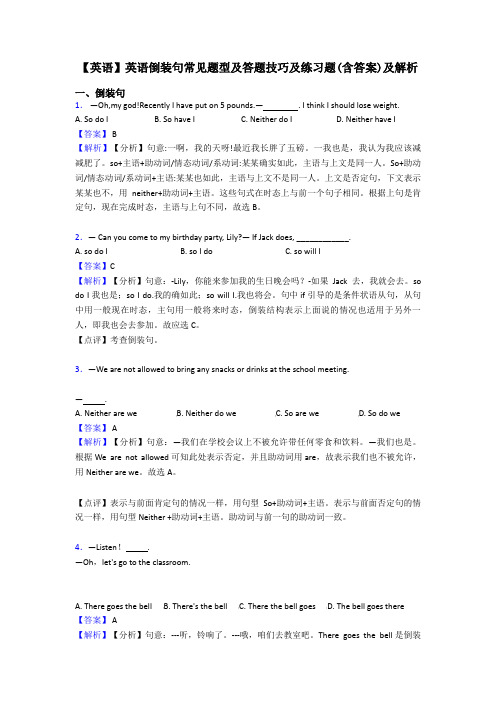
【英语】英语倒装句常见题型及答题技巧及练习题(含答案)及解析一、倒装句1.—Oh,my god!Recently I have put on 5 pounds.—. I think I should lose weight.A. So do IB. So have IC. Neither do ID. Neither have I【答案】 B【解析】【分析】句意:一啊,我的天呀!最近我长胖了五磅。
一我也是,我认为我应该减减肥了。
so+主语+助动词/情态动词/系动词:某某确实如此,主语与上文是同一人。
So+助动词/情态动词/系动词+主语:某某也如此,主语与上文不是同一人。
上文是否定句,下文表示某某也不,用neither+助动词+主语。
这些句式在时态上与前一个句子相同。
根据上句是肯定句,现在完成时态,主语与上句不同,故选B。
2.— Can you come to my birthday party, Lily?— If Jack does, ____________.A. so do IB. so I doC. so will I【答案】C【解析】【分析】句意:-Lily,你能来参加我的生日晚会吗?-如果Jack去,我就会去。
so do I我也是;so I do.我的确如此;so will I.我也将会。
句中if引导的是条件状语从句,从句中用一般现在时态,主句用一般将来时态,倒装结构表示上面说的情况也适用于另外一人,即我也会去参加。
故应选C。
【点评】考查倒装句。
3.—We are not allowed to bring any snacks or drinks at the school meeting.— .A. Neither are weB. Neither do weC. So are weD. So do we【答案】 A【解析】【分析】句意:—我们在学校会议上不被允许带任何零食和饮料。
- 1、下载文档前请自行甄别文档内容的完整性,平台不提供额外的编辑、内容补充、找答案等附加服务。
- 2、"仅部分预览"的文档,不可在线预览部分如存在完整性等问题,可反馈申请退款(可完整预览的文档不适用该条件!)。
- 3、如文档侵犯您的权益,请联系客服反馈,我们会尽快为您处理(人工客服工作时间:9:00-18:30)。
【英语】英语倒装句解题技巧及经典题型及练习题(含答案)一、倒装句1.– Will Tony go for the picnic at the weekend?– If I don't go, ______.A. so does heB. neither will heC. neither he does【答案】 B【解析】【分析】neither+主语+谓语,表示对前句所说内容的肯定,neither+谓语+主语,表示前句所说情况也适用于后者,句意:Tony周末去野餐吗?如果我不去,他也不去。
前句情况也适用于后者,所以用倒装,故选B。
【点评】考查倒装句的用法。
2.—Many students won 't take part in the after-school activities today.— .We have so much homework to do!A. So will IB. So do IC. Neither will ID. Neither do I【答案】 C【解析】【分析】句意:—今天许多学生不愿意参见课外活动。
—我也不愿意。
我们有那么多作业要做。
So+助动词+主语,表示与前面的肯定形式一致,表示也。
Neither+助动词+主语,表示与前面的否定形式一致,表示也不。
这两种部分倒装结构中的助动词与前一句的助动词一致,根据Many students won 't take part in the after-school activities today.可知此处won't表示否定形式,故用Neither+will+主语,故选C。
【点评】此题考查倒装句。
注意助动词与前一句的助动词一致。
3.—Zhou Ming likes reading English magazines.—_______. It's good for English learning.A. So do IB. So am IC. So I do【答案】 A【解析】【分析】句意为:—周明喜欢读英语杂志。
—我也是。
这对英语学习由好处。
So+助动词+主语,完全倒装,表示“.......也......”。
故选A。
【点评】考查倒装句4.—I'm waiting for the visitors very anxiously.—Look, here ______ these visitors.A. comeB. comesC. goD. goes【答案】 A【解析】【分析】句意:—我焦急地等待着来访者。
—瞧,这些来访者来了。
A. come动词,来;B. comes动词三单;来;C. go动词,走;D. goes动词三单,走。
根据语义可知,本句为倒装句,主语为these visitors,复数含义,谓语动词使用原形;come here来这里,而不是go here去这里。
故选:A。
【点评】此题考查倒装句。
5.—My brother got up very early last Sunday.—________.A. So I didB. So I wasC. So did I【答案】 C【解析】【分析】句意:——上星期天我哥哥起得很早。
——我也是。
so+谓语+主语,……也是,so+主语+谓语,的确是,此处表示某人也是,因此用so did I,故选C。
【点评】考查固定搭配,注意so+谓语+主语的用法。
6.— I have changed my job.— __________________.A. So do IB. So have IC. So I doD. So I have【答案】 B【解析】【分析】句意:——我已经换了工作。
——我也是。
根据时态是现在完成时故助动词是have,故排除A和C选项,so+助动词+主语,……也是,so+主语+助动词,的确是,此处表示我也是,故选B。
【点评】考查省略句,注意so+助动词+主语的用法。
7.— Do you know Jim quarreled with his brother?— I don't know, _______________.A. nor do I careB. nor don't I careC. I don't care, neitherD. I don't care, also 【答案】 A【解析】【分析】句意:——你知道吉姆和他哥哥吵架了吗?——我不知道,我也不在乎。
nor+谓语+主语,用于否定句,……也是,故选A。
【点评】考查固定句型,注意nor+谓语+主语的用法。
8.—Lily doesn't go to the museum this weekend. What about you, Millie?—If Lily doesn't go there, ____.A. so do IB. so will IC. neither do ID. neither will I【答案】 D【解析】【分析】句意:——莉莉这个周末不去博物馆。
你呢,米莉?——如果莉莉不去那儿,我也不去。
So+助动词+主语,表示主语也是;neither+助动词+主语,表示主语也不是这样。
根据if从句是一般现在时,主句用一般将来时。
主句是否定结构,可知此处倒装结构用neither或nor引导,故选D。
【点评】考查倒装句。
掌握so和neither引导的倒装结构的区别。
9.—We have never been to America. What about Jeff?—____. He hopes to visit it some day.A. So does heB. Neither does heC. So has heD. Neither has he【答案】 D【解析】【分析】句意:——我们从未去过美国。
杰夫怎么样?——他也没去过。
他希望有一天能去参观。
把副词so放在句首,表示前面的情况也适用于另一个或物,其句型是:so+be(have,助动词或情态动词)+主语。
把副词neither放在句首,表示前面否定的内容也适用于另一个或物,其句型是:neither(nor)+be(have,助动词或情态动词)+主语。
这是倒装结构。
前面的句子有never,表示否定,谓语动词是have,所以用neither(nor)+have+主语。
主语是第三人称单数he,用has,故答案为D。
【点评】考查倒装和固定搭配。
注意neither(nor)+be(have,助动词或情态动词)+主语结构的用法。
10.--Peter knows many people here.---_________________A. So do IB. So am IC. Neither am ID. Neither do I【答案】 A【解析】【分析】So do I我也一样;So am I.我也是;Neither am I我也不;Neither do I 我也不。
句意:彼得认识这儿的许多人。
结合语境可知上文为一般现在时态,主谓结构,故选A。
【点评】这几个倒装句的区别比较难。
“so+助动词(情态动词或连系动词)+另一主语”,此句型是主谓倒装结构,可以表示前面的情况也适用于后者,使用该句型需要注意以几个方面的问题:1.该句型只能用于肯定句,不能用于否定句:如果前句是否定句,则要用“neither /nor +助动词+主语”。
2.句型中的主语与上文中的主语是不同的两个主语3.句型中助动词,包括连系动词和情态动词的时态要和上句中谓语动词的时态相一致。
另一句型so+主语+助动词是指对上文的肯定,起加强作用。
11.—I've finished my homework, Tony.—_______.A. So have IB. So I haveC. So did ID. So I did【答案】 A【解析】【分析】句意:托尼,我已经完成了我的作业。
——我也是。
So +助动词+主语,表示同样,也;So+主语+助动词,表示的确,确实。
结合句意,表示也做完了,故排除BD 两项。
根据I've 可知此处的助动词是have, 故选A。
【点评】考查倒装句的用法。
12.——Last Sunday Fred gave out food at the food bank.—— _______. And _________.A. So did he, so did IB. So he did, so I didC. So did he, so I didD. So he did, so did I【答案】 D【解析】【分析】句意:上周日弗莱德在食物银行分发食物。
他确实在,我也在。
“so+助动词(情态动词或连系动词)+另一主语”,此句型是主谓倒装结构,可以表示前面的情况也适用于后者,使用该句型需要注意以几个方面的问题:1.该句型只能用于肯定句,不能用于否定句:如果前句是否定句,则要用“neither /nor +助动词+主语”。
2.句型中的主语与上文中的主语是不同的两个主语3.句型中助动词,包括连系动词和情态动词的时态要和上句中谓语动词的时态相一致。
4. 如果第二分句只是重复前句的意思,用来表示赞同时,so之后的主语和谓语就不能颠倒。
所以选D。
【点评】考查so的用法。
13.-I don't know about you, but I'm sick and tired of this weather.-_______. I can't stand all this rain.A. I don't careB. It's hard to sayC. So am ID. I hope not【答案】 C【解析】【分析】A. I don't care 我不在乎 B. It's hard to say很难说C. So am I 我也是 D. I hope not我希望不要这样;句意:我不知道你的情况,但是我生病了,讨厌这种天气。
我也是,我忍受不了这雨了。
故选C【点评】“So+谓语+主语”此句型为倒装结构,其主语与上文句子中的主语是不同的。
so代表上句中陈述的肯定内容。
谓语可以是连系动词、情态动词或助动词,且必须与上句中的谓语动词保持时态的一致,意思为“…也是如此”。
“So+ 主 + 谓”表示讨论同一人做某事。
14.— I can't stand (忍受) the air pollution in this city any more. It is getting more terrible.— ________. We've never had so many factories before.A. Neither I can .B. Neither can IC. So I can.D. So can I.【答案】 B【解析】【分析】句意:-我不能在忍受这个城市里的空气污染了,它变得更糟糕了。
